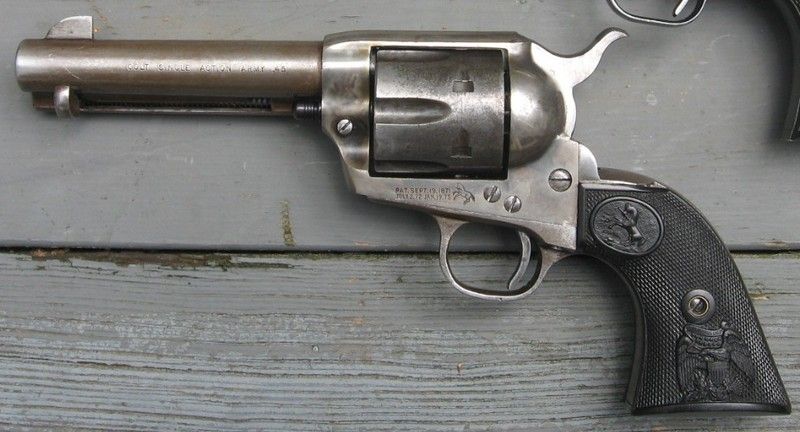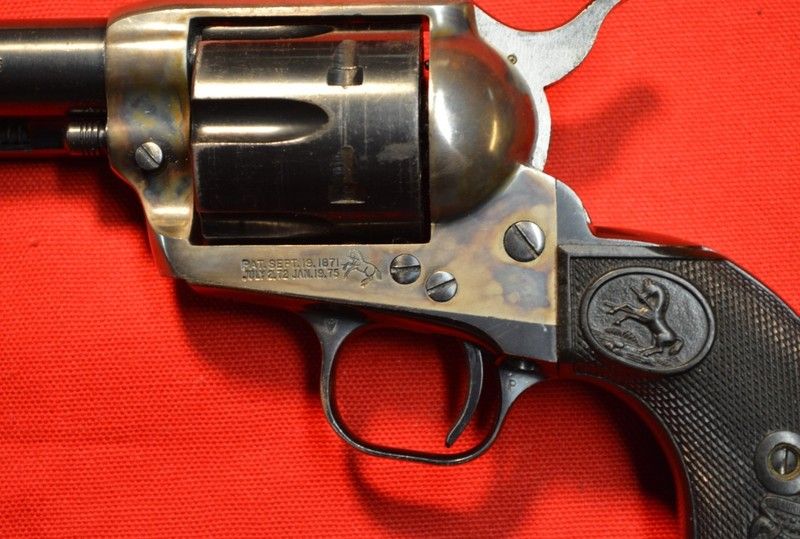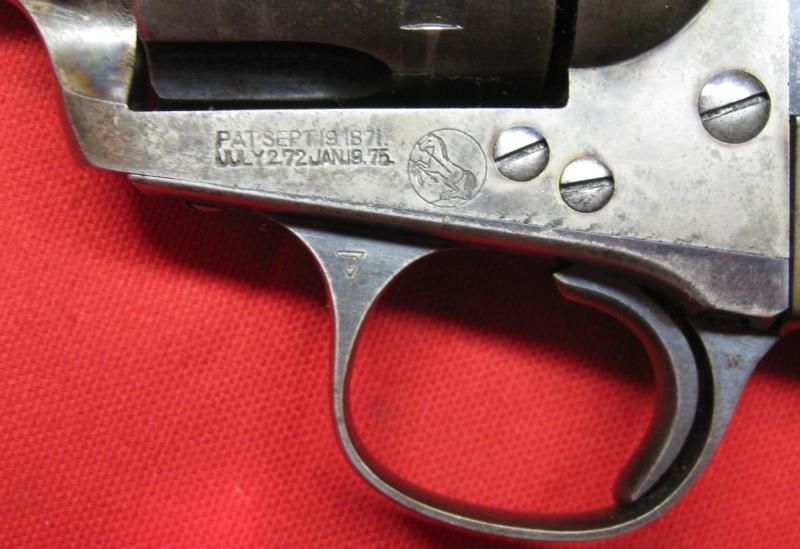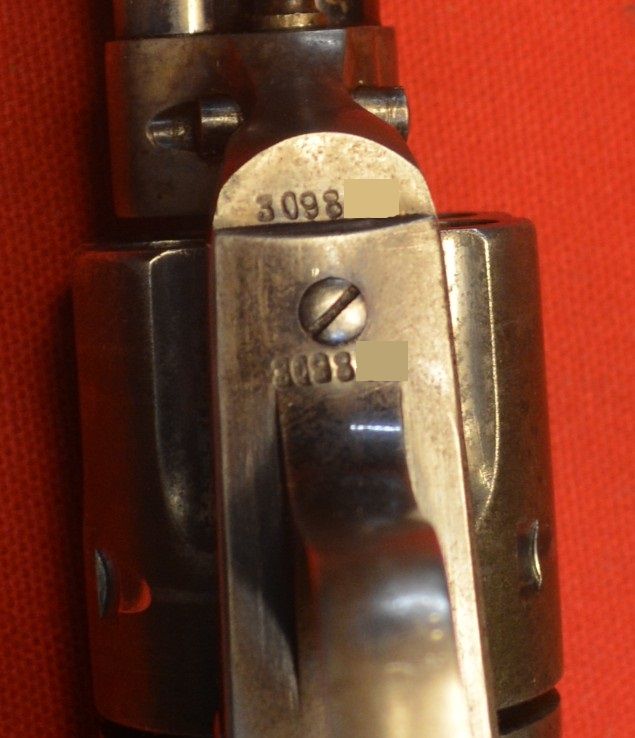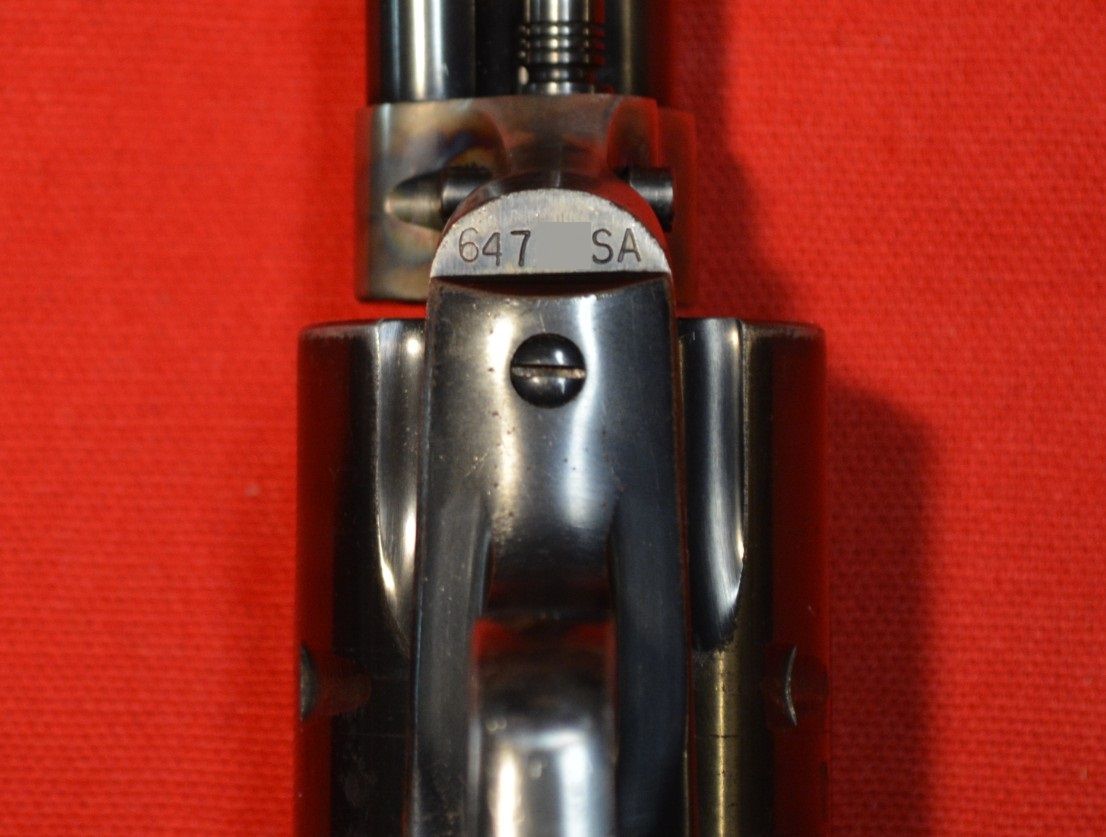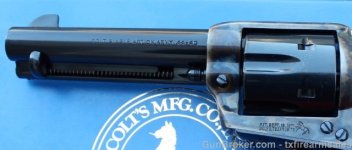The post I was responding to stated "ANY Colt SAA chambered in 44-40". However, if he meant a first gen then I misunderstood him.
I was referring to ANY SAA chambered for 44-40, but I like to say you learn something new every day.
But more important, let's talk for a minute about shooting old revolvers with Smokeless powder vs Black Powder.
Number 1. It is not the frame of a revolver that has to withstand the pressure of a cartridge firing, it is the cylinder. The cylinder is the pressure vessel that contains the pressure. The frame is simply a thing that holds the cylinder in place. If a revolver blows up, most of the time it is the cylinder that will burst.
This is the cylinder from a 19th Century Merwin Hulbert that saw too much pressure. The cylinder has burst in an absolutely typical manner. The first photo shows where the rupture started, at the thinnest cross section, where the cylinder locking slot is milled into the circumference of the cylinder. That is usually the weakest point on most revolver cylinders. The crack propigated forward, splitting along the centerline of the chamber, and the piece separated from the cylinder, taking the topstrap along with it. Notice how the two adjacent chambers started to deform. If the pressure had been greater, the walls separating the two adjacent chambers from the blown chamber would have folded like accordions, and those two chambers would have been daylighted too.
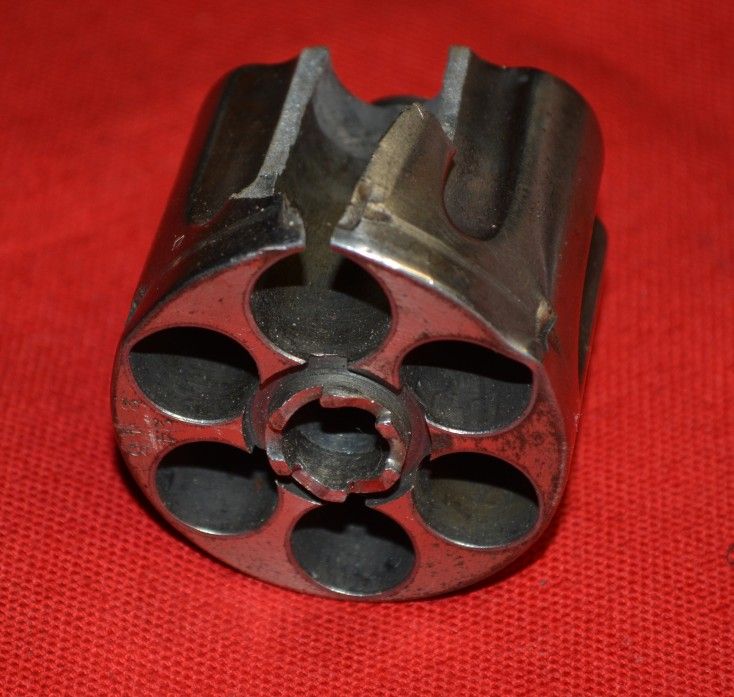
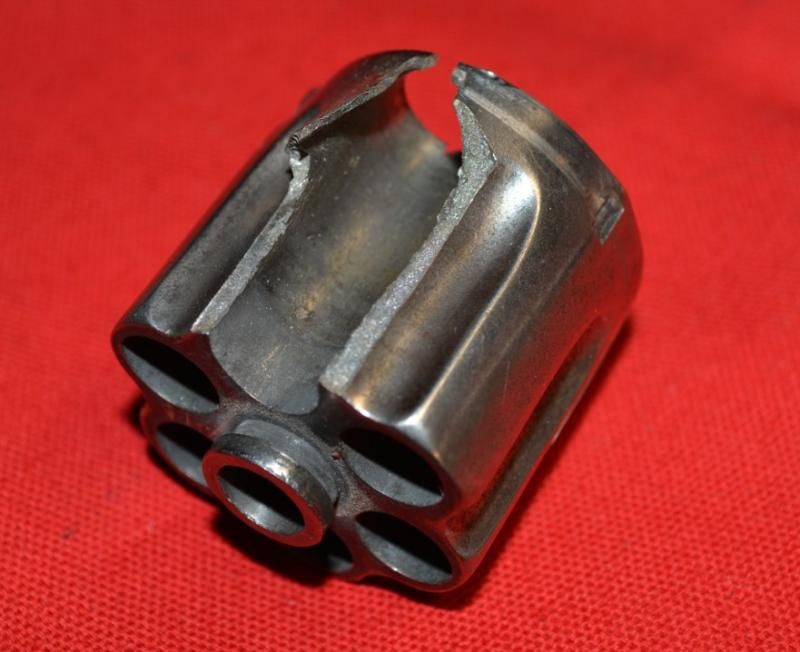
That is what a burst cylinder usually looks like. Unless there is an obstruction in the barrel, the barrel seldom bursts, because the cross section of the barrel walls are greater than the weakest part of the cylinder. In some cases, with an obstruction in the barrel, the barrel will burst, but with no obstruction in the barrel it is usually the cylinder that bursts, usually bending or taking the top strap along with it.
The frame does not have to contain the pressure of a cartridge firing. The frame does have to deal with the concussion caused by the cartridge slamming backwards in recoil, but that is an entirely different force than the pressure generated by a cartridge firing. A weak or fragile frame may stretch from repeated heavy recoil, internal parts may be distorted by heavy recoil, but a frame is not going to burst. If very old and fragile, it may crack from the concussion of recoil, but it is not going to burst from the pressure of a cartridge firing.
Now, let's talk specifically about the metals Colt was using to make 1st Generation (1873-1940) Single Action Army revolvers. I am quoting the following information from Jerrry Kuhnhausen's "The Colt Single Action Revolvers, a Shop Manual, Volumes 1 & 2".
Page 70, Frame Material Notes:
"(1) Early black powder model SAA frames up to about s/n 96,000 (SAA frames manufactured through about mid 1883) were made of malleable iron. (2) Intermediate SAA frames between approx. s/n 96,000 and 180,000 (SAA frames manufactured from about mid 1883 through mid 1898) vary but were apparently made of transitional materials generally similar to modern low-medium carbon steels. The lowest carbon content found in intermediate s/n SAA frames tested to date is approx. .0155, indicating the possibility that early formulations of 1015-1018 or higher carbon type steels may have been used in many frames of this era. (3) Although there are exceptions, frames manufactured after s/n 180,000 appear to have been made from medium range carbon steels. The lowest carbon content found in the after s/n 180,000 frames tested was approx. .0213, possibly indicating that 1020-1027, or slightly higher, carbon, or similar, steels may have been used in these frames."
Page 71, Cylinder material notes:
"(1) 1st Generation SAA cylinder material changes began to occur at about the same time that SAA frames were being metallurgically updated. Cylinders prior to approx. s/n 96,000 were made from materials generally resembling high grade malleable iron. Original Cylinders from approx. s/n 96,000 to about 180,000 were made from transitional low/medium carbon type steels. These cylinders and their parent frames were not factory guaranteed for smokeless powder cartridges. Cylinders after frame s/n 180,000 (about mid 1898) began to be made from medium carbon type steels. Later versions of these cylinders were better and more uniformly heat treated. SAA Revolvers with cylinders of this final type were factory guaranteed in 1900 for standard factory load smokeless powder cartridges. (2) 1st Generation .357 Magnum cylinders were made from fine grain, high tensile strength ordinance quality steel. These cylinder blanks, identified by a 5 pointed star on the front, turn up on other caliber SAA’s made during, and after, 1935."
I typed this stuff up a long time ago because I knew I would have occasion to refer back to it.
Anyway, notice that the materials the frames and cylinders were made from pretty much track together for the same time periods. Notice what is said about the cylinders (remember, the cylinder is the pressure vessel, not the frame) regarding the steady progression of materials up until Colt felt confident to factory warranty the SAA in 1900 for 'standard factory load smokeless powder cartridges'.
After about 1900, Colt began stamping a VP, for Verified Proof in an inverted triangle on the left front side of the trigger guard, indicating that the gun was safe to fire with Smokeless powder cartridges.
Here is the Verified Proof symbol on the trigger guard of a Bisley Colt made in 1908.
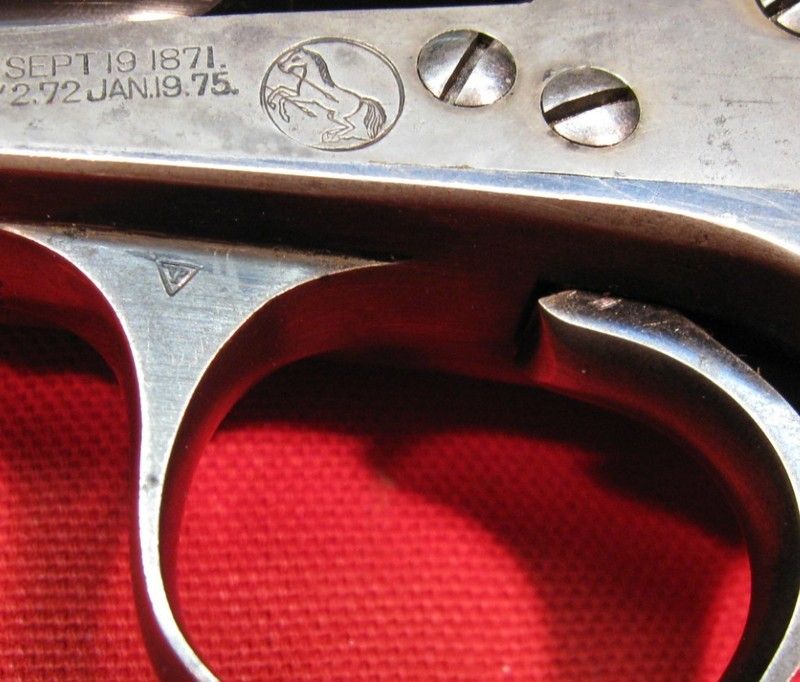
I have argued till I am blue in the face over the years about why these old revolvers should not be fired with Smokeless powder. It is not the amount of pressure, it is the pressure coupled with the amount of time the pressure lasts. Most Smokeless powders generate a sharp spike of pressure. Particularly the fast powders usually used for pistol loads. Black Powder on the other hand generates a gentler curve, which lasts a longer time, measured in milliseconds. It ain't anything we can hear, but sophisticated pressure equipment can. Even if you reduce the pressure of a Smokeless load down to Black Powder levels, the pressure spike is much more abrupt, and the old steel may not be able to contain it without bursting. Think about trying to tow a car with a rope. If you accelerate slowly and gradually, the rope may be able to take the strain, and you may be able to get the towed car rolling. But if you accelerate with a jerk, the rope may not be able to take the strain, and may break. It is the same thing with relatively weak metals. Subject it to pressure gradually, and the metal may take the pressure, but do it too abruptly, and the metal may not be elastic enough to yield without breaking.
I argue about this stuff all the time with a guy over on the S&W Forum. He maintains that it is indeed possible to choose Smokeless powders that will duplicate the gentler pressure curve of Black Powder, both in amplitude and duration, so that these powders can be used in the old guns. He is probably correct, choosing the correct powder, with a relatively slow burn rate, it is probably possible to develop Smokeless loads for the old guns. But I do not have the pressure measuring equipment, nor the patience to develop these loads. No, I do not remember what powders he was specifying, if you want to know you will have to ask him. But I guarantee you it was not Unique. Unique burns much too fast.
All this is not to say that the first time you fire an old gun with Smokeless ammo it is guaranteed to blow up. In fact, most old guns have probably been fired with Smokeless ammo at some time or another. But who knows how much the old metal has been strained over time, and who knows when it will reach its limit? I am not going to risk it with my old Colts or S&W Top Breaks.
For the record, it is much tougher to pin down S&W as to when they felt their revolvers could safely be fired with Smokeless powder. The early catalogs from around 1900 specifically say they do not guarantee their revolvers for Smokeless powder. They hedge their bets a bit, claiming they have no control over the quality of
reloaded ammunition made with the relatively new Smokeless powders. Somewhere around 1909 or 1910 S&W started factory guaranteeing their revolvers for Smokeless powder. Personally, I don't believe S&W had access to steels that were any better than Colt could get, so I never fire my antique Top Breaks, including my 44 Russian New Model Number Threes, with anything but ammunition I load with Black Powder.
I completely understand the aversion some folks may have to cleaning up after shooting Black Powder. I understand that completely. I can only say that after shooting Black Powder for many years in cartridge revolvers I have developed some techniques that make clean up much easier. Yes, it is always messy, but it does not have to be difficult. And contrary to what some might have heard, one does not have to clean a gun the same day after shooting with Black Power, for fear it will turn into a pile of rust.

